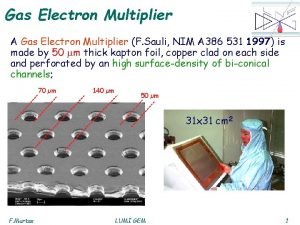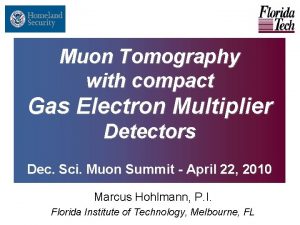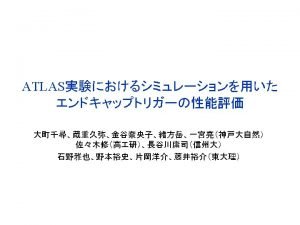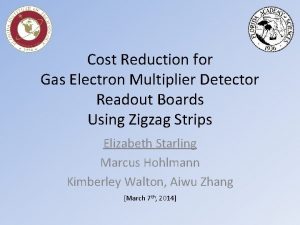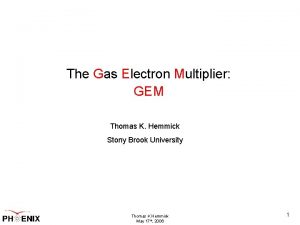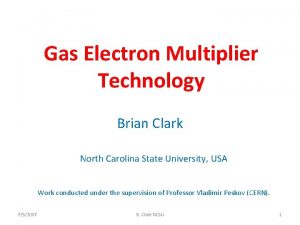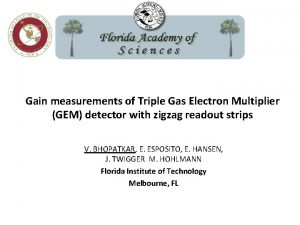Development of Gas Electron Multiplier Detectors for Muon














- Slides: 14

Development of Gas Electron Multiplier Detectors for Muon Tomography M. Abercrombie, A. Quintero, A. Menendez, K. Gnanvo, M. Hohlmann Physics and Space Science Department Florida Institute of Technology M. Abercrombie - Florida Academy of Sciences - March 19, 2010

Overview � Why GEMs? � How GEMs work � Assembly process � Improvements M. Abercrombie - Florida Academy of Sciences - March 19, 2010

Why GEMs? � Compact design, versatile � Better spatial resolution than similar techniques (50 -100 µm) � Relatively low cost � Uses naturally occurring, ubiquitous cosmic ray muons, easily penetrate high z materials � Well suited for muon tomography of potential nuclear contraband. M. Abercrombie - Florida Academy of Sciences - March 19, 2010

GEM Foils �GEM foils are made of a thin sheet of Kapton covered on both sides by copper �High density of tiny, chemically etched holes (~100 per mm 2) �Foils stretched, framed, and glued; delicate and tedious process M. Abercrombie - Florida Academy of Sciences - March 19, 2010

Testing the Foils � Cleanroom � N 2 gas flow � Voltage of 500 V applied � Expect a leakage current of less than 5 n. A Image taken at CERN M. Abercrombie - Florida Academy of Sciences - March 19, 2010

How GEMs Work � Multiple foils stacked inside the detector � Sealed and put under Ar/CO 2 gas mixture � Voltage applied to the foils creates a uniform electric field between foils M. Abercrombie - Florida Academy of Sciences - March 19, 2010

How GEMs Work � Muon ionizes the Ar/CO 2 gas in the detector � Electrons from ionization process move toward the readout plane � Accelerated by high electric field, excites more electrons ◦ Cascade of electrons � Readout in 2 dimensions M. Abercrombie - Florida Academy of Sciences - March 19, 2010

Our Set Up at Florida Tech • HV Power Supply • HV Circuit Board • 10 cm x 10 cm detector • Preamp • Oscilloscope • Gas Flow M. Abercrombie - Florida Academy of Sciences - March 19, 2010

Our Set Up at CERN Prototype for a Muon Tomography station o determine incoming and outgoing paths o angle of deflection gives target composition Four 30 cm x 30 cm GEM detectors 3 cm x 3 cm target M. Abercrombie - Florida Academy of Sciences - March 19, 2010

Results from CERN: Gain Curve � Gain defined as ratio of collected charges at readout to primary charge � Logarithmic behavior M. Abercrombie - Florida Academy of Sciences - March 19, 2010

Results from CERN: Uniformity Test � Test for consistent readout across the detector Position (cm) 1 (0) 2 (4) 3 (7. 8) 4 (11. 6) 5 (15. 5) 6 (19. 5) 7 (21. 1) Total Average Stan Dev. Average Peak (ADC) 1434 1395 1341. 5 1342 1566 1498 1384 7 6 5 4 3 2 1 1422. 929 83. 36987 M. Abercrombie - Florida Academy of Sciences - March 19, 2010

Results from CERN: Spectra � Energy spectrum of Cu X-rays in blue � Cosmic ray muon pulse height distribution in red (5 hours) M. Abercrombie - Florida Academy of Sciences - March 19, 2010

Improvements � Goal: Avoid tedious framing procedure � How: Use honeycomb spacers between the foils ◦ will ensure that the GEM foils are flat ◦ will not require that the foils be framed M. Abercrombie - Florida Academy of Sciences - March 19, 2010

Future Work � Obtain a signal with our 10 cm x 10 cm detector � Test the performance of honeycomb spacers between foils � Construction of a 30 cm x 30 cm detector with honeycomb spacers Learn more at: http: //research. fit. edu/hep_lab. A/ M. Abercrombie - Florida Academy of Sciences - March 19, 2010
 Gas electron multiplier
Gas electron multiplier Where are feature detectors located
Where are feature detectors located Feature detectors ap psychology
Feature detectors ap psychology Rhmd: evasion-resilient hardware malware detectors
Rhmd: evasion-resilient hardware malware detectors Feature detectors
Feature detectors Frontier detectors for frontier physics
Frontier detectors for frontier physics Diagnosing error in object detectors
Diagnosing error in object detectors What is thermal detector
What is thermal detector Streaming current
Streaming current Vhv voltage detectors
Vhv voltage detectors Photo detectors
Photo detectors Nuclear detectors
Nuclear detectors Which detector used in hplc
Which detector used in hplc Giant wave detectors murmurs universe
Giant wave detectors murmurs universe Giant gravitational wave detectors hear murmurs
Giant gravitational wave detectors hear murmurs
